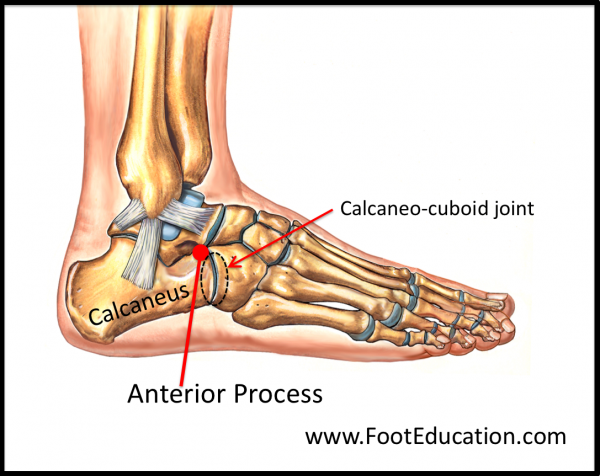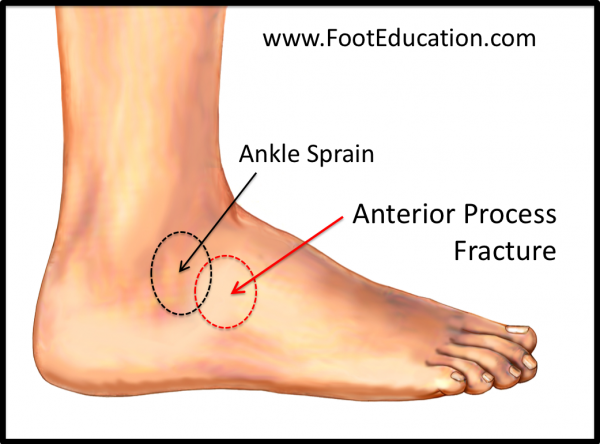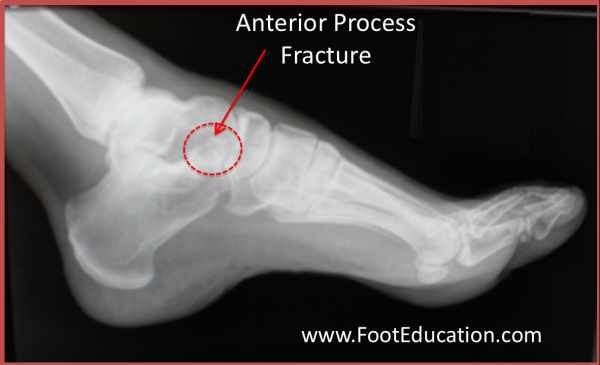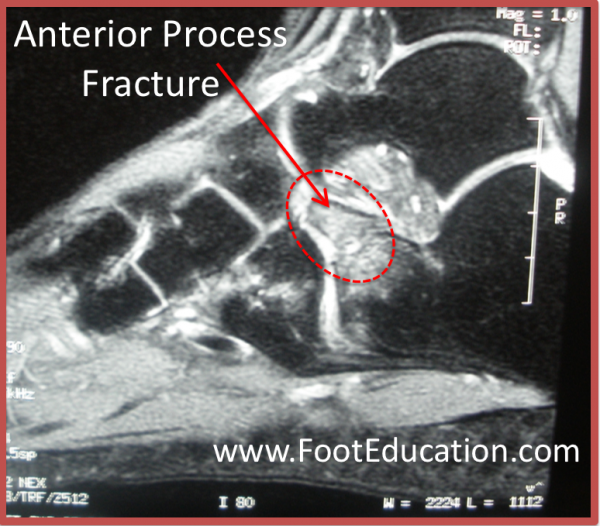Anterior Process Fracture of the Calcaneus
Summary
Fractures of the anterior process of the calcaneus are a relatively uncommon acute injury involving the prominence on the heel bone located in front and to the outside of the ankle (Figure 1). The mechanism of injury and symptoms are very similar to a bad ankle sprain which is a much more common injury. As a result, these fractures are often initially misdiagnosed as an ankle sprain. Most anterior process fractures of the calcaneus can be treated non-surgically. If the fracture is displaced or symptoms persist surgical removal of the fracture fragment may be required.
Clinical Presentation of an Anterior Process Fracture of the Calcaneus
The anterior process of the calcaneus is a prominence on the heel bone (calcaneus) that is located in front and to the outside of the ankle (Figure 1). Fractures of the anterior process of the calcaneus occur following an acute injury to the foot. The way the injury occurs is often similar to that of an ankle sprain, where the foot is flexed in an inward and downward direction. The fracture occurs when the calcaneus and cuboid bones that make up the calcaneocuboid joint smash against each other. This knocks off a rim of bone at the top part of the calcaneus process. In some instances, a ligament attached to the anterior process of the calcaneus is stretched with the foot in this position and pulls off a portion of the bone (avulsion fracture). Usually, the fracture does not shift significantly. Patients with this type of fracture typically report pain and swelling in front of and to the outside of the ankle. Although the injury is quite painful, patients may be able to walk with limp. These fractures are often misdiagnosed as ankle sprains because the injury mechanism and resulting symptoms are similar.

Clinical Examination
On examination, there will be tenderness and swelling over the injured area. The injured area is similar to that of an ankle sprain, although it is located closer to the toes than a standard ankle sprain (Figure 2). The skin and sensation is usually normal. However, occasionally this injury can cause the nerve that runs on the outside of the foot (sural nerve) to be irritated, leading to a sural neuritis with burning or numbness over the outside of the foot.

Imaging Studies
A fracture of the anterior process of the calcaneus can usually be seen on a lateral view of a plain x-ray of the foot (Figure 3). This is a view taken from the side. However, the x-ray findings of this fracture can often be quite subtle and therefore can be easily missed. If the diagnosis is in question it can be established by a CT scan or an MRI. These studies will show evidence of the small fracture fragment involving the anterior process of the calcaneus (Figure 4).


Treatment of a Fracture of the Anterior Process of the Calcaneus
Non-Operative Treatment
The first step in successful treatment of a fracture of the anterior process of the calcaneus is to establish the correct diagnosis. Given the similar mechanism and presenting symptoms many of these injuries are misdiagnosed as an ankle sprain –a much more common injury.
Most anterior process fractures of the calcaneus can be treated non-surgically. If the fracture fragment is not interfering with the function of the calcaneocuboid joint, non-operative treatment is indicated. This consists of immobilization in a walker boot for typically six weeks, until the soft tissue injury and fracture have healed. In some incidences, the fracture will not completely heal, which is only problematic if it interferes with the calcaneocuboid joint function.
Operative Treatment
Surgical treatment of anterior calcaneal process fractures are reserved for fractures that interfere with the function of the calcaneocuboid joint. For example, if the fracture is in such a position that the bone is irritating the calcaneocuboid joint, then surgical removal of this fragment is indicated.
In addition, patients that have persistent symptoms following this type of fracture may benefit from surgical removal and cleaning out of the calcaneocuboid joint. Recovery from this surgery involves protecting the foot until the soft tissues have healed, and then gradually mobilizing the joint. This can take six weeks or more.
Potential Complications of Surgical Treatment
Complications that are specific to the removal of an anterior process of the calcaneus fracture include:
- Injury to the sural nerve – The sural nerve runs on the outside of the foot and can lead to numbness or a persistent burning sensation in this area.
- Arthritis of the calcaneal cuboid joint – Arthritis affecting the calcaneocuboid joint can occur, although this is unusual.
- Persistence of symptoms – The injured area may have ongoing pain.
Edited on September 30th, 2025. Previously edited by Samuel Dellenbaugh MD, Daniel Cuttica DO, and Stephen Pinney MD